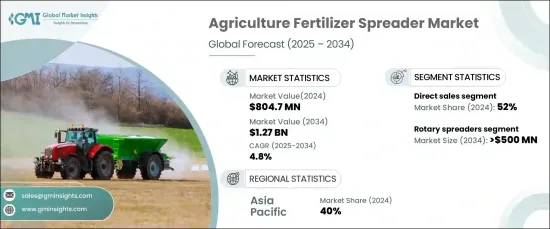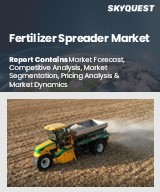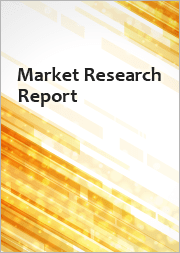
|
시장보고서
상품코드
1665378
농업용 비료 살포기 시장 기회, 성장 촉진요인, 산업 동향 분석, 예측(2025-2034년)Agriculture Fertilizer Spreader Market Opportunity, Growth Drivers, Industry Trend Analysis, and Forecast 2025 - 2034 |
||||||
세계의 농업용 비료 살포기 시장은 2024년에 8억 470만 달러로 평가되며, 2025-2034년에 CAGR 4.8%로 성장할 것으로 예측됩니다. 이러한 확대는 인구 증가에 따른 세계 식량 수요 증가가 원동력이 되고 있습니다. 도시화와 환경 문제로 인해 경작지가 감소함에 따라 효율적인 농업 기술이 필수적입니다. 비료 살포기는 영양분을 정확하게 살포하고, 낭비를 최소화하며, 작물 수확량을 높이는 데 중요한 역할을 합니다. 이러한 효율성은 지속가능성 목표와도 부합하며, 식량 생산을 향상시키면서 환경에 미치는 영향을 줄일 수 있습니다. 토양 황폐화, 기후 변화, 부적절한 농업 관행과 같은 문제는 토양 침식과 영양분 손실에 대응하는 이러한 첨단 툴의 필요성을 증가시키고 있습니다. 가변 시비량 및 토양 모니터링과 같은 첨단 기술을 탑재한 최신 비료 살포기는 세계 식량안보를 보장하고 농업 생산을 최적화하는 데 필수적입니다.

농업의 현대화를 촉진하기 위한 정부의 구상은 시장 성장을 더욱 촉진할 것입니다. 보조금, 보조금, 재정적 인센티브는 농업 종사자들이 비료 살포기와 같은 첨단 장비를 도입하도록 장려하고 있습니다. 예를 들어 농업 경제 국가의 예산의 대부분은 식량 및 비료 보조금에 할당되어 농업 현대화에 대한 약속을 강조하고 있습니다. 이러한 재정적 지원은 첨단 장비에 대한 초기 투자를 지원할 뿐만 아니라 소규모 농업 종사자들이 경제적 장벽을 극복할 수 있도록 돕고, 보다 광범위한 도입을 촉진합니다.
| 시장 범위 | |
|---|---|
| 시작연도 | 2024년 |
| 예측연도 | 2025-2034년 |
| 시작 금액 | 8억 470만 달러 |
| 예측 금액 | 12억 7,000만 달러 |
| CAGR | 4.8% |
시장은 회전식, 건식, 낙하식, 진자식, 액체 살포기 등 살포기 유형에 따라 분류됩니다. 이 중 회전식 살포기는 2024년 40% 이상의 압도적인 시장 점유율을 차지하며, 2034년에는 5억 달러 이상에 달할 것으로 예측됩니다. 회전식 살포기의 인기 비결은 넓은 면적을 효율적으로 커버하고 다양한 유형의 비료를 처리할 수 있기 때문입니다. 이러한 적응성은 다양한 농업 용도에 적합하며, 농업 부문 전반 수요를 증가시키고 있습니다.
비료 살포기의 유통은 직접 판매, 소매, 온라인 플랫폼을 통해 이루어지며, 2024년에는 직접 판매이 52%로 선도합니다. 농업 종사자들이 직접 판매를 선호하는 이유는 개별 상담에 따라 필요에 맞는 장비를 확실히 제공하기 때문입니다. 이러한 채널은 또한 애프터 서비스, 보증, 리스 및 할부 계획과 같은 유연한 자금 조달 옵션을 촉진하여 특히 개발도상국의 농업 종사자들이 쉽게 접근할 수 있도록 합니다.
아시아태평양은 2024년 40%의 점유율을 차지하며, 중국과 같은 국가들이 시장을 주도하고 있습니다. 이 지역에서는 노동력 부족과 식량 수요 증가에 대응하기 위해 농업의 기계화가 빠르게 진행되고 있습니다. 비료 살포기는 농법 현대화를 위한 정부 정책 및 구상에 힘입어 생산성을 향상시키는 데 필수적인 장비입니다. 정밀농업 기술 및 지속가능한 농법의 채택은 이러한 툴에 대한 수요를 더욱 가속화하여 효율적인 자원 사용과 환경 영향 감소를 보장합니다.
목차
제1장 조사 방법과 조사 범위
- 조사 디자인
- 조사 어프로치
- 데이터 수집 방법
- 기본 추정과 계산
- 기준연도 산출
- 시장 추정의 주요 동향
- 예측 모델
- 1차 조사와 검증
- 1차 정보
- 데이터 마이닝 소스
- 시장 스코프와 정의
제2장 개요
제3장 산업 인사이트
- 에코시스템 분석
- 원료·부품 공급업체
- 제조업체
- 기술 프로바이더
- 유통업체
- 최종사용자
- 공급업체 상황
- 이익률 분석
- 기술과 혁신 전망
- 특허 분석
- 주요 뉴스 & 구상
- 규제 상황
- 가격 분석
- 영향요인
- 촉진요인
- 세계의 식량 수요 증가에 의해 효율적인 농법이 필요하다.
- GPS 대응 살포기 등 정밀농업 기술의 채택
- 지속가능성 노력이 효율적인 비료 살포 툴의 수요를 촉진
- 현대적 농업 기기에 대한 정부의 보조금과 지원
- 산업의 잠재적 리스크·과제
- 첨단 비료 살포기 높은 초기 비용
- 소규모 농업 종사자의 인식과 기술적 전문 지식의 결여
- 촉진요인
- 성장 가능성 분석
- Porter의 산업 분석
- PESTEL 분석
제4장 경쟁 구도
- 서론
- 기업 점유율 분석
- 경쟁 포지셔닝 매트릭스
- 전략 전망 매트릭스
제5장 시장 추정·예측 : 살포기별, 2021-2034년
- 주요 동향
- 로터리 살포기
- 건식 살포기
- 낙하식 살포기
- 진자식 살포기
- 액체 살포기
제6장 시장 추정·예측 : 비료별, 2021-2034년
- 주요 동향
- 입상 비료
- 액체 비료
- 유기 비료
- 화학 비료
제7장 시장 추정·예측 : 기술별, 2021-2034년
- 주요 동향
- 수동식
- 유압식
- GPS 대응
- 가변 레이트 기술(VRT)
- 무선통신 시스템
제8장 시장 추정·예측 : 동력원별, 2021-2034년
- 주요 동향
- 트랙터 탑재형
- 자주식
- 수동식
- ATV/UTV 탑재
제9장 시장 추정·예측 : 용도별, 2021-2034년
- 주요 동향
- 밭작물
- 과수원
- 상업용 잔디와 정원
제10장 시장 추정·예측 : 유통 채널별, 2021-2034년
- 주요 동향
- 직접 판매
- 소매
- 온라인 플랫폼
제11장 지역별 시장 추정·예측 : 지역별, 2021-2034년
- 주요 동향
- 북미
- 미국
- 캐나다
- 유럽
- 영국
- 독일
- 프랑스
- 이탈리아
- 스페인
- 러시아
- 북유럽
- 아시아태평양
- 중국
- 인도
- 일본
- 호주
- 한국
- 동남아시아
- 라틴아메리카
- 브라질
- 멕시코
- 아르헨티나
- 중동 및 아프리카
- 아랍에미리트
- 남아프리카공화국
- 사우디아라비아
제12장 기업 개요
- AGCO
- Bogballe
- Bredal
- Claas
- CNH Industrial
- Dalton
- Fertilizer Equipment Specialists
- IRIS Spreaders
- John Deere
- Kasco Manufacturing
- Kubota
- Kuhn
- Kverneland
- Mahindra &Mahindra
- Maschio Gaspardo
- Monosem
- Rauch Landmaschinenfabrik
- Sulky Burel
- Techint
- Vicon
The Global Agriculture Fertilizer Spreader Market, valued at USD 804.7 million in 2024, is projected to grow at a 4.8% CAGR from 2025 to 2034. This expansion is driven by the rising global demand for food, necessitated by population growth. As urbanization and environmental challenges reduce arable land, efficient farming techniques become essential. Fertilizer spreaders play a critical role by applying nutrients precisely, minimizing waste, and boosting crop yields. This efficiency also aligns with sustainability objectives, reducing environmental impact while improving food production. Challenges like soil degradation, climate change, and poor agricultural practices exacerbate the need for such advanced tools, which address soil erosion and nutrient loss. Modern fertilizer spreaders, featuring advanced technologies like variable rate application and soil monitoring, are indispensable for ensuring global food security and optimizing agricultural output.

Government initiatives promoting agricultural modernization further bolster market growth. Subsidies, grants, and financial incentives encourage farmers to adopt advanced equipment like fertilizer spreaders. For instance, a significant portion of budgets in agrarian economies is allocated to food and fertilizer subsidies, underscoring the commitment to modernizing agriculture. These financial aids not only support the initial investment in advanced tools but also help small-scale farmers overcome economic barriers, fostering broader adoption.
| Market Scope | |
|---|---|
| Start Year | 2024 |
| Forecast Year | 2025-2034 |
| Start Value | $804.7 Million |
| Forecast Value | $1.27 Billion |
| CAGR | 4.8% |
The market is segmented based on spreader types, including rotary, dry, drop, pendulum, and liquid spreaders. Among these, rotary spreaders held a dominant market share of over 40% in 2024, with projections exceeding USD 500 million by 2034. Their popularity stems from their ability to cover large areas efficiently and handle diverse fertilizer types. This adaptability makes them suitable for various agricultural applications, enhancing their demand across the farming sector.
The distribution of fertilizer spreaders occurs through direct sales, retail, and online platforms, with direct sales leading the market at 52% in 2024. Farmers favor direct sales due to personalized consultations and tailored solutions that ensure the right equipment for their needs. These channels also facilitate after-sales services, warranties, and flexible financing options like leasing and installment plans, enabling easier access for farmers, particularly in developing regions.
Asia Pacific dominated the market with a 40% share in 2024, led by countries like China. The region is experiencing rapid agricultural mechanization to address labor shortages and increasing food demands. Fertilizer spreaders are integral to improving productivity supported by government policies and initiatives aimed at modernizing farming practices. The adoption of precision farming techniques and sustainable practices further accelerates the demand for these tools, ensuring efficient resource use and reduced environmental impact.
Table of Contents
Chapter 1 Methodology & Scope
- 1.1 Research design
- 1.1.1 Research approach
- 1.1.2 Data collection methods
- 1.2 Base estimates & calculations
- 1.2.1 Base year calculation
- 1.2.2 Key trends for market estimation
- 1.3 Forecast model
- 1.4 Primary research and validation
- 1.4.1 Primary sources
- 1.4.2 Data mining sources
- 1.5 Market scope & definition
Chapter 2 Executive Summary
- 2.1 Industry 3600 synopsis, 2021 - 2034
Chapter 3 Industry Insights
- 3.1 Industry ecosystem analysis
- 3.1.1 Raw material and component suppliers
- 3.1.2 Manufacturers
- 3.1.3 Technology providers
- 3.1.4 Distributors
- 3.1.5 End users
- 3.2 Supplier landscape
- 3.3 Profit margin analysis
- 3.4 Technology & innovation landscape
- 3.5 Patent analysis
- 3.6 Key news & initiatives
- 3.7 Regulatory landscape
- 3.8 Pricing analysis
- 3.9 Impact forces
- 3.9.1 Growth drivers
- 3.9.1.1 Increasing global food demand necessitates efficient agricultural practices
- 3.9.1.2 Adoption of precision agriculture technologies such as GPS-enabled spreaders
- 3.9.1.3 Sustainability efforts drive demand for efficient fertilizer application tools
- 3.9.1.4 Government subsidies and support for modern farming equipment
- 3.9.2 Industry pitfalls & challenges
- 3.9.2.1 High initial costs of advanced fertilizer spreaders
- 3.9.2.2 Lack of awareness and technical expertise among small-scale farmers
- 3.9.1 Growth drivers
- 3.10 Growth potential analysis
- 3.11 Porter’s analysis
- 3.12 PESTEL analysis
Chapter 4 Competitive Landscape, 2024
- 4.1 Introduction
- 4.2 Company market share analysis
- 4.3 Competitive positioning matrix
- 4.4 Strategic outlook matrix
Chapter 5 Market Estimates & Forecast, By Spreader, 2021 - 2034 ($Bn, Units)
- 5.1 Key trends
- 5.2 Rotary spreaders
- 5.3 Dry spreaders
- 5.4 Drop spreaders
- 5.5 Pendulum spreaders
- 5.6 Liquid spreaders
Chapter 6 Market Estimates & Forecast, By Fertilizer, 2021 - 2034 ($Bn, Units)
- 6.1 Key trends
- 6.2 Granular fertilizers
- 6.3 Liquid fertilizers
- 6.4 Organic fertilizers
- 6.5 Chemical fertilizers
Chapter 7 Market Estimates & Forecast, By Technology, 2021 - 2034 ($Bn, Units)
- 7.1 Key trends
- 7.2 Manual
- 7.3 Hydraulic
- 7.4 GPS-enabled
- 7.5 Variable rate technology (VRT)
- 7.6 Wireless communication systems
Chapter 8 Market Estimates & Forecast, By Power Source, 2021 - 2034 ($Bn, Units)
- 8.1 Key trends
- 8.2 Tractor-mounted
- 8.3 Self-propelled
- 8.4 Hand-pushed
- 8.5 ATV/UTV mounted
Chapter 9 Market Estimates & Forecast, By Application, 2021 - 2034 ($Bn, Units)
- 9.1 Key trends
- 9.2 Row crops
- 9.3 Orchards
- 9.4 Commercial lawns & gardens
Chapter 10 Market Estimates & Forecast, By Distribution Channel, 2021 - 2034 ($Bn, Units)
- 10.1 Key trends
- 10.2 Direct sales
- 10.3 Retail
- 10.4 Online platforms
Chapter 11 Market Estimates & Forecast, By Region, 2021 - 2034 ($Bn, Units)
- 11.1 Key trends
- 11.2 North America
- 11.2.1 U.S.
- 11.2.2 Canada
- 11.3 Europe
- 11.3.1 UK
- 11.3.2 Germany
- 11.3.3 France
- 11.3.4 Italy
- 11.3.5 Spain
- 11.3.6 Russia
- 11.3.7 Nordics
- 11.4 Asia Pacific
- 11.4.1 China
- 11.4.2 India
- 11.4.3 Japan
- 11.4.4 Australia
- 11.4.5 South Korea
- 11.4.6 Southeast Asia
- 11.5 Latin America
- 11.5.1 Brazil
- 11.5.2 Mexico
- 11.5.3 Argentina
- 11.6 MEA
- 11.6.1 UAE
- 11.6.2 South Africa
- 11.6.3 Saudi Arabia
Chapter 12 Company Profiles
- 12.1 AGCO
- 12.2 Bogballe
- 12.3 Bredal
- 12.4 Claas
- 12.5 CNH Industrial
- 12.6 Dalton
- 12.7 Fertilizer Equipment Specialists
- 12.8 IRIS Spreaders
- 12.9 John Deere
- 12.10 Kasco Manufacturing
- 12.11 Kubota
- 12.12 Kuhn
- 12.13 Kverneland
- 12.14 Mahindra & Mahindra
- 12.15 Maschio Gaspardo
- 12.16 Monosem
- 12.17 Rauch Landmaschinenfabrik
- 12.18 Sulky Burel
- 12.19 Techint
- 12.20 Vicon



















